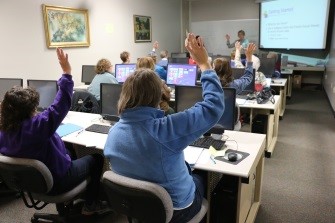Growing One Book at a Time with Summer Reading!

Schools and libraries across the country, as well as organizations, such as Scholastic and Barnes & Noble®, offer many reading challenges and activities for students during the summer. Public Libraries began actual summer reading programs in the 1890’s to encourage children to read during the months when they were not in school; receiving continuous exposure to literature and reading instruction. These summer reading programs incentivize students to keep reading in the summer to retain skills for positive reading achievement outcomes when returning to school in the fall.
How can we all help our students with print disabilities can take advantage of these summer reading activities and sustain reading skills, practice reading, and read for enjoyment? As parents and educators we can:
PROVIDE ACCESS MATCH BOOKS GIVE SUPPORT
- Providing Access to Reading Material
In 1978, pioneering researcher on summer reading, Barbara Heyns, found that the “number of books read during the summer is consistently related to achievement gains.” This proves the importance of providing many accessible books and other reading material to students with print disabilities. Let us help by ordering existing or new books through AIM-VA now! With accessible formats that match the needs of your students, they will be able to individualize their reading preferences (modify the font, use text-to-speech, annotate on the text) using features designed to remove decoding barriers.
- Matching Books to Student Readers
As your students select books to read during summer vacation, educators and parents can help guide them to books of interest at their appropriate reading level. The use of Reading Interest Inventories and/or Reading Attitude Surveys can provide insight to student’s attitude and interest with reading. The following video by study.com, provides some help in why surveying student interest promotes reading achievement.

- Give Support as Student Reads
Before school ends for the summer, educators need not only gather accessible reading materials but offer students reading support. One way might be for educators to provide a SUMMER READING CHALLENGE or SUMMER READING LOG.
AIM-VA can help by converting these logs into accessible formats using our Curriculum-Based Materials service. In doing this as summer reading activities are being prepared, students are given the opportunity to keep and update their reading accomplishments on their home computer or mobile device. This will help them keep their books and reading materials organized and reading activities all in the same place.
For parents or family members, supporting the use of these summer reading logs as well as providing opportunities to talk-about books being read and/or reading books or parts of books aloud will promote reading as a family value.
The Virginia Department of Education (VDOE) states:
Let AIM-VA help you pull a summer reading program together now to enable all students in your class to enjoy and comprehend those good summer books we all know and love!
Resources:
Kim, J. S. (2006). Effects of a voluntary summer reading intervention on reading achievement: Results from a randomized field trial. Educational Evaluation and Policy Analysis, 28 (4), 335-355.
Kim, J. S. & White, T. G. (2008). Scaffolding voluntary summer reading for children in grades 3 to 5: An experimental study. Scientific Studies of Reading, 12(1), 1-23.
Heyns, B. (1978). Summer learning and the effects of schooling. New York: Academic Press, Inc.









